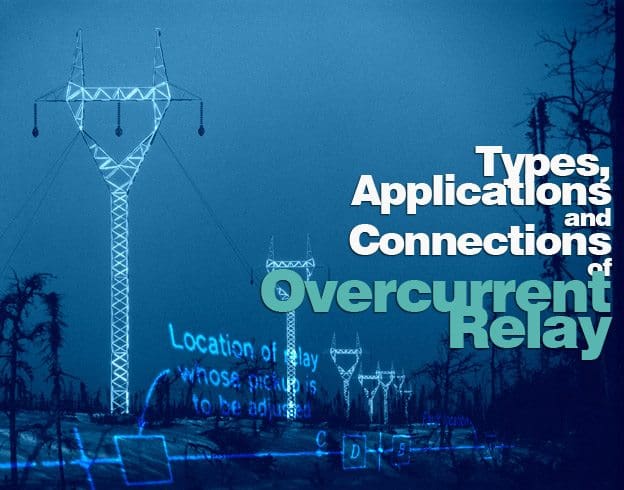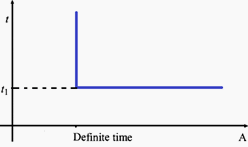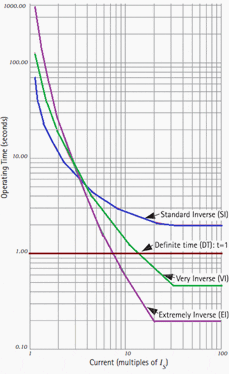
Index
- Types of protection:
- Unit Type Protection
- Non-unit schemes
- Overcurrent protection
- Earth fault protection
- Various types of Line Faults
- Overcurrent Relay Purpose and Ratings
- Primary requirement of Overcurrent protection
- Purpose of overcurrent Protection
- Overcurrent Relay Ratings
- Difference between Overcurrent and Overload protection
- Types of Overcurrent Relay:
- Instantaneous Overcurrent relay (Define Current)
- Definite Time Overcurrent Relays
- Inverse Time Overcurrent Relays (IDMT Relay)
- Normal Inverse Time Overcurrent Relay
- Very Inverse Time Overcurrent Relay
- Extremely Inverse Time Overcurrent Relay
- Directional Overcurrent Relays
- Application of Overcurrent Relay
Types of protection
Protection schemes can be divided into two major groupings:
- Unit schemes
- Non-unit schemes
1. Unit Type Protection
Unit type schemes protect a specific area of the system, i.e., a transformer, transmission line, generator or bus bar.
The unit protection schemes is based on Kirchhoff’s Current Law – the sum of the currents entering an area of the system must be zero.
Any deviation from this must indicate an abnormal current path.
In these schemes, the effects of any disturbance or operating condition
outside the area of interest are totally ignored and the protection
must be designed to be stable above the maximum possible fault current
that could flow through the protected area.
2. Non unit type protection
The non-unit schemes, while also intended to protect specific areas, have no fixed boundaries.
As well as protecting their own designated areas, the protective zones
can overlap into other areas. While this can be very beneficial for
backup purposes, there can be a tendency for too great an area to be
isolated if a fault is detected by different non unit schemes.
The
most simple of these schemes measures current and incorporates an
inverse time characteristic into the protection operation to allow
protection nearer to the fault to operate first.
The non unit type protection system includes following schemes:
- Time graded overcurrent protection
- Current graded overcurrent protection
- Distance or Impedance Protection
2.1 Overcurrent protection
This is the simplest of the ways to protect a line and therefore widely used.
It owes its application from the fact that in the event of fault
the current would increase to a value several times greater than
maximum load current. It has a limitation that it can be applied only to
simple and non costly equipments.
2.2 Earth fault protection
The general practice is to employ a set of two or three overcurrent relays and a separate overcurrent relay for single line to ground fault. Separate earth fault relay provided makes earth fault protection faster and more sensitive.
Earth fault current is always less than phase fault current in magnitude.
Therefore, relay connected for earth fault protection is different from those for phase to phase fault protection.
Various types of Line Faults
| No | Type of Fault | Operation of Relay |
| 1 | Phase to Ground fault (Earth Fault) | Earth Fault Relay |
| 2 | Phase to Phase fault Not with Ground | Related Phase Overcurrent relays |
| 3 | Double phase to Ground fault | Related Phase Overcurrent relays and Earth Fault relays |
Overcurrent Relay Purpose and Ratings
A relay that operates or picks up when it’s current exceeds a predetermined value (setting value) is called Overcurrent Relay.
Overcurrent protection protects electrical power systems against excessive currents which are caused by short circuits, ground faults,
etc. Overcurrent relays can be used to protect practically any power
system elements, i.e. transmission lines, transformers, generators, or
motors.
For feeder protection, there would be more than one
overcurrent relay to protect different sections of the feeder. These
overcurrent relays need to coordinate with each other such that the
relay nearest fault operates first.
Use time, current and a combination of both time and current are three ways to discriminate adjacent overcurrent relays.
OverCurrent Relay gives protection against:
Overcurrent includes short-circuit protection, and short circuits can be:
- Phase faults
- Earth faults
- Winding faults
Short-circuit currents are generally several times (5 to 20) full load current. Hence fast fault clearance is always desirable on short circuits.
Primary requirement of Overcurrent protection
The protection should not operate for starting currents, permissible overcurrent, current surges. To achieve this, the time delay is provided (in case of inverse relays).
The protection should be co-ordinate with neighboring overcurrent protection.
Overcurrent relay is a basic element of overcurrent protection.
Purpose of overcurrent Protection
These are the most important purposes of overcurrent relay:
- Detect abnormal conditions
- Isolate faulty part of the system
- Speed Fast operation to minimize damage and danger
- Discrimination Isolate only the faulty section
- Dependability / reliability
- Security / stability
- Cost of protection / against cost of potential hazards
Overcurrent Relay Ratings
In
order for an overcurrent protective device to operate properly,
overcurrent protective device ratings must be properly selected. These
ratings include voltage, ampere and interrupting rating.
If the interrupting rating is not properly selected, a serious hazard for equipment and personnel will exist.
Current
limiting can be considered as another overcurrent protective device
rating, although not all overcurrent protective devices are required to
have this characteristic
Voltage Rating:
The voltage rating of the overcurrent protective device must be at
least equal to or greater than the circuit voltage. The overcurrent
protective device rating can be higher than the system voltage but never
lower.
Ampere Rating:
The ampere rating of a overcurrent protecting device normally should
not exceed the current carrying capacity of the conductors As a general
rule, the ampere rating of a overcurrent protecting device is selected
at 125% of the continuous load current.
Difference between Overcurrent and Overload protection
Overcurrent protection protects against excessive currents or currents beyond the acceptable current ratings, which are resulting from short circuits, ground faults and overload conditions.
While, the overload protection protects against the situation where overload current causes overheating of the protected equipment.
The
overcurrent protection is a bigger concept So that the overload
protection can be considered as a subset of overcurrent protection.
The overcurrent relay can be used as overload (thermal)
protection when protects the resistive loads, etc., however, for motor
loads, the overcurrent relay cannot serve as overload protection
Overload relays usually have a longer time setting than the overcurrent
relays.
Types of Overcurrent Relay
These are the types of overcurrent relay:
- Instantaneous Overcurrent (Define Current) Relay
- Define Time Overcurrent Relay
- Inverse Time Overcurrent Relay (IDMT Relay)
- Moderately Inverse
- Very Inverse Time
- Extremely Inverse
- Directional overcurrent Relay
1. Instantaneous Overcurrent relay (Define Current)
Definite current relay operate instantaneously when the current reaches a predetermined value.
 |
Instantaneous Overcurrent Relay - Definite Current
|
- Operates in a definite time when current exceeds its Pick-up value.
- Its operation criterion is only current magnitude (without time delay).
- Operating time is constant.
- There is no intentional time delay.
- Coordination of definite-current relays is based on the fact that the fault current varies with the position of the fault because of the difference in the impedance between the fault and the source
- The relay located furthest from the source operate for a low current value
- The operating currents are progressively increased for the other relays when moving towards the source.
- It operates in 0.1s or less
Application: This type is applied to the outgoing feeders.
2. Definite Time Overcurrent Relays
In this type, two conditions must be satisfied for operation (tripping), current must exceed the setting value and the fault must be continuous at least a time equal to time setting of the relay.
 |
| Definite time of overcurrent relay |
Modern relays may contain more than one stage of protection each stage includes each own current and time setting.
- For Operation of Definite Time Overcurrent Relay operating time is constant
- Its operation is independent of the magnitude of current above the pick-up value.
- It has pick-up and time dial settings, desired time delay can be set with the help of an intentional time delay mechanism.
- Easy to coordinate.
- Constant tripping time independent of in feed variation and fault location.
Drawback of Relay:
- The continuity in the supply cannot be maintained at the load end in the event of fault.
- Time lag is provided which is not desirable in on short circuits.
- It is difficult to co-ordinate and requires changes with the addition of load.
- It is not suitable for long distance transmission lines where rapid fault clearance is necessary for stability.
- Relay have difficulties in distinguishing between Fault currents at one point or another when fault impedances between these points are small, thus poor discrimination.
Application:
Definite time overcurrent relay is used as:
- Back up protection of distance relay of transmission line with time delay.
- Back up protection to differential relay of power transformer with time delay.
- Main protection to outgoing feeders and bus couplers with adjustable time delay setting.
3. Inverse Time Overcurrent Relays (IDMT Relay)
In
this type of relays, operating time is inversely changed with current.
So, high current will operate overcurrent relay faster than lower ones.
There are standard inverse, very inverse and extremely inverse types.
Discrimination by both ‘Time’ and ‘Current’. The relay operation time is inversely proportional to the fault current.
Inverse Time relays are also referred to as Inverse Definite Minimum Time (IDMT) relay.
 |
| Inverse Definite Minimum Time (IDMT) |
The operating time of an overcurrent relay can be moved up (made slower) by adjusting the ‘time dial setting’. The lowest time dial setting (fastest operating time) is generally 0.5 and the slowest is 10.
- Operates when current exceeds its pick-up value.
- Operating time depends on the magnitude of current.
- It gives inverse time current characteristics at lower values of fault current and definite time characteristics at higher values
- An inverse characteristic is obtained if the value of plug setting multiplier is below 10, for values between 10 and 20 characteristics tend towards definite time characteristics.
- Widely used for the protection of distribution lines.
Based on the inverseness it has three different types:
 |
Inverse types
|
3.1. Normal Inverse Time Overcurrent Relay
The
accuracy of the operating time may range from 5 to 7.5% of the nominal
operating time as specified in the relevant norms. The uncertainty of
the operating time and the necessary operating time may require a
grading margin of 0.4 to 0.5 seconds.
It’s used when Fault Current is dependent on generation of fault not fault location.
Normal inverse time Overcurrent Relay is relatively small change in time per unit of change of current.
Application:
Most
frequently used in utility and industrial circuits. especially
applicable where the fault magnitude is mainly dependent on the system
generating capacity at the time of fault.
3.2. Very Inverse Time Overcurrent Relay
- Gives more inverse characteristics than that of IDMT.
- Used where there is a reduction in fault current, as the distance from source increases.
- Particularly effective with ground faults because of their steep characteristics.
- Suitable if there is a substantial reduction of fault current as the fault distance from the power source increases.
- Very inverse overcurrent relays are particularly suitable if the short-circuit current drops rapidly with the distance from the substation.
- The grading margin may be reduced to a value in the range from 0.3 to 0.4 seconds when overcurrent relays with very inverse characteristics are used.
- Used when Fault Current is dependent on fault location.
- Used when Fault Current independent of normal changes in generating capacity.
3.3. Extremely Inverse Time Overcurrent Relay
- It has more inverse characteristics than that of IDMT and very inverse overcurrent relay.
- Suitable for the protection of machines against overheating.
- The operating time of a time overcurrent relay with an extremely inverse time-current characteristic is approximately inversely proportional to the square of the current
- The use of extremely inverse overcurrent relays makes it possible to use a short time delay in spite of high switching-in currents.
- Used when Fault current is dependent on fault location
- Used when Fault current independent of normal changes in generating capacity.
Application:
- Suitable for protection of distribution feeders with peak currents on switching in (refrigerators, pumps, water heaters and so on).
- Particular suitable for grading and coordinates with fuses and re closes
- For the protection of alternators, transformers. Expensive cables, etc.
3.4. Long Time Inverse Overcurrent Relay
The main application of long time overcurrent relays is as backup earth fault protection.
4. Directional Overcurrent Relays
When
the power system is not radial (source on one side of the line), an
overcurrent relay may not be able to provide adequate protection. This
type of relay operates in on direction of current flow and blocks in the
opposite direction.
Three conditions must be satisfied for its
operation: current magnitude, time delay and directionality. The
directionality of current flow can be identified using voltage as a
reference of direction.
Application of Overcurrent Relay
Motor Protection:
- Used against overloads and short-circuits in stator windings of motor.
- Inverse time and instantaneous overcurrent phase and ground
- Overcurrent relays used for motors above 1000 kW.
Transformer Protection:
- Used only when the cost of overcurrent relays are not justified.
- Extensively also at power-transformer locations for external-fault back-up protection.
Line Protection:
- On some sub transmission lines where the cost of distance relaying cannot be justified.
- primary ground-fault protection on most transmission lines where distance relays are used for phase faults.
- For ground back-up protection on most lines having pilot relaying for primary protection.
Distribution Protection:
Overcurrent relaying is very well suited to distribution system protection for the following reasons:
- It is basically simple and inexpensive.
- Very often the relays do not need to be directional and hence no PT supply is required.
- It is possible to use a set of two O/C relays for protection against inter-phase faults and a separate Overcurrent relay for ground faults.
No comments:
Post a Comment